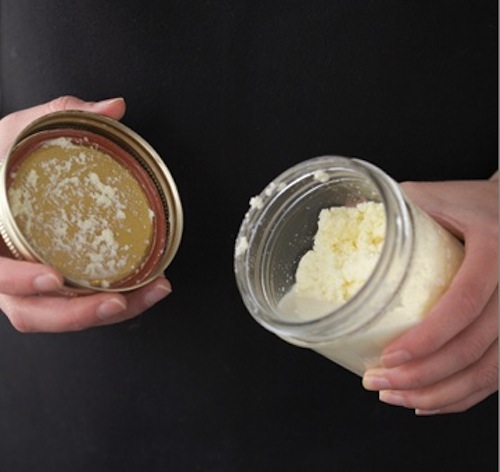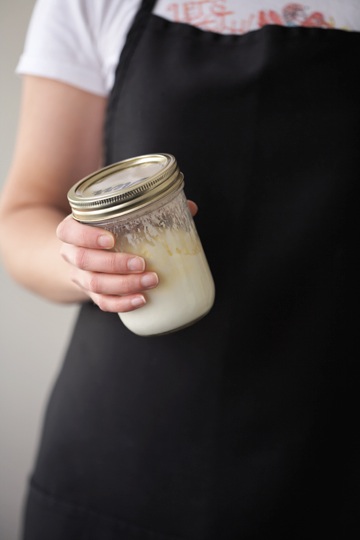The best way to invigorate and involve your Thanksgiving guests is to put them to work in the kitchen. Some can carve, others can mash, but many profess to having the kitchen equivalent to two black thumbs. For the well-intentioned but culinarily challenged, give them a mission-critical task: Make the Thanksgiving butter.
Gather the kids and the couch potatoes and give them the following: Fresh, top quality heavy whipping cream and a clean, odorless jar with a tight-fitting lid. Pour, cap, shake (and pass), shake (and pass), and shake that cream until the butterfat separates from the buttermilk and voila–you've got kitchen alchemy in your hands, yielding the taste of fresh dairy.
It's too good not to pass around the table, particularly when flavored with fragrant herbs, roasted nuts, or sweet brown sugar. Now, if you would, please pass the butter…
Prep Ahead
You’ll need a clean, 1-pint jar with a snug-fitting lid. Before filling the jar with heavy cream, shake with water to make sure the jar doesn’t leak. You'll also need 1 cup heavy whipping cream and (optionally) 1/2 teaspoon kosher salt.
Instructions
- Allow the cream to come to room temperature. Note that if you skip this step you can still make butter, but you will be doing the “shake the butter” dance for longer.
- Pour the cream into a jar with a tight lid that’s at least twice the capacity of the cream. Shake, shake, and shake the cream—butter will happen in 20 to 30 minutes. Shake vigorously, but be careful not to harm your wrists or hurl any high-speed glass jars across the room. The cream will thicken into stiff whipped cream first. Then, moments later, the butter will separate and form a solid mass apart from the buttermilk. Give a few more shakes to ensure you’ve finished the job.
- Pour the buttermilk into a bowl and reserve. Continue to shake the butter by itself, pouring off the buttermilk, a couple more times.
- Add just enough water to cover the solid butter, shake vigorously, and discard the liquid down the drain. Do this 3 or 4 more times, until the liquid from the jar is clear. (Note that if you plan to use the buttermilk, you don’t want to mix it with this additional water.)
- Spoon the butter into a bowl, pouring off any excess liquid. Add the salt, if desired. Or, if you’re making compound butters, go ahead and add your other ingredients now. If you’re using decorative molds, spoon the butter into them now. For a long stick of butter, pour it onto a 12-inch piece of waxed paper or parchment paper, and gently roll it up into a long and thin log. Whatever shape it takes, refrigerate for 30 to 45 minutes.
How to Store It
 Refrigerate, tightly wrapped, up to 2 weeks. For long-term storage, double-wrap very tightly in plastic wrap, place in a sealable plastic bag, and freeze.
Refrigerate, tightly wrapped, up to 2 weeks. For long-term storage, double-wrap very tightly in plastic wrap, place in a sealable plastic bag, and freeze.
Variations
To get the most out of your compound butter (see below), spoon it onto a 12-inch piece of waxed paper or parchment paper and gently roll it up, tightening it from the center outward as you go, into a long and thin log. Refrigerate to harden for about 45 minutes.
Once firm, slice the butter in the paper into 1-inch pieces, and store in the freezer in a marked sealable plastic bag. You do not need to thaw butter before using; it can go straight from freezer to pan.
- Walnut and Roasted Red Pepper Butter: Combine 9 walnut halves, toasted, 1/4 cup roasted red pepper (page 35), 1 teaspoon salt, and 1/2 cup room-temperature butter in a food processor. Process for 1 minute, until the pepper and the nuts are finely chopped and incorporated throughout. Enjoy over vegetables like roasted asparagus, spinach or potatoes.
-
Dill and Mustard Butter: Combine 2 tablespoons chopped fresh dill, 2 teaspoons prepared Mustard (see page 26), 1 teaspoon salt, and 1/2 cup room-temperature butter, and mash in a bowl. Melt over seared or grilled chicken or pork.
-
Caramelized Onion and Thyme Butter: Caramelize the onions by heating 2 tablespoons vegetable oil in a sauté pan over medium-high heat, adding 1 teaspoon salt. Add a chopped yellow onion, and when it starts to brown lower the heat to medium, stirring occasionally for 20 to 25 minutes until the onion turns golden brown all over. Let the onion cool, and combine with 1/2 cup room-temperature butter, 1 teaspoon salt, 2 tablespoons chopped fresh thyme, and 1/2 teaspoon black pepper in a food processor for 1 minute, until all the ingredients are finely minced and incorporated into the butter. This is wonderful with winter squash and makes a great pan sauce with steak.









